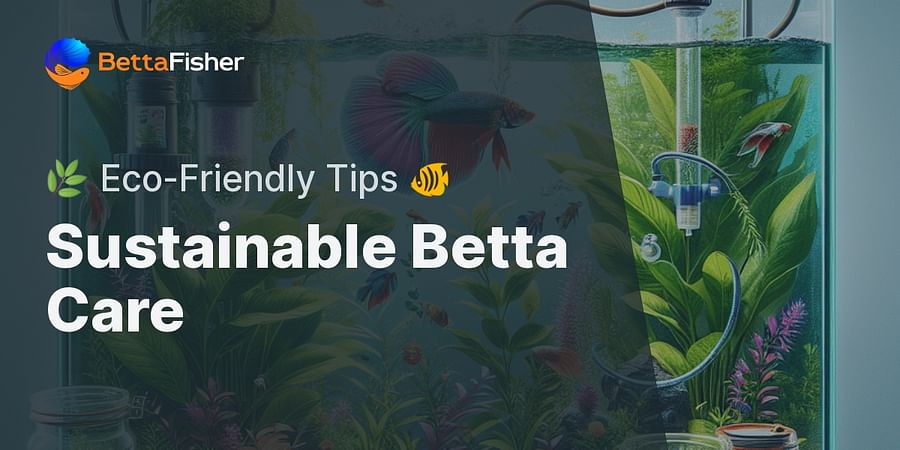Eco-Friendly Betta Care: Tips for a Sustainable Betta Fish Tank Setup

When it comes to caring for betta fish, the traditional approach often overlooks the impact our choices have on the environment. But as awareness grows, so does the desire for sustainable practices in all aspects of life—including how we care for our aquatic friends. In this article, we'll dive into eco-friendly betta care and explore how you can set up a sustainable betta fish tank that's not only kind to your fish but also to Mother Earth.
Finding your finned companion should be done with both care and consciousness. Sourcing from reputable breeders or adopting from rescues ensures that you're supporting ethical breeding practices and helping reduce the demand for bettas caught in the wild. Not only does this promote better health and genetic diversity among captive bettas, but it also helps protect wild populations and their habitats.
Your betta's home is where they'll spend all their time, so it's vital to get it right—not just for their health and happiness but for environmental sustainability as well. Opting for a tank made from recycled or sustainably sourced materials is a fantastic start. Additionally, consider the size of your tank; larger volumes not only provide a better quality of life for your betta but can also be more stable and energy-efficient in the long run.




When setting up your tank, think about avoiding common mistakes that could harm both your fish and the environment. For instance, overstocking or poor filtration can lead to water quality issues that may require more frequent water changes—increasing water consumption unnecessarily.
Live plants are not just decorative; they play a crucial role in creating a balanced ecosystem within your tank. They absorb carbon dioxide, produce oxygen, help control algae growth, and can even reduce pollutants in the water. Using live plants instead of plastic ones reduces waste and avoids potential toxins leaching into the water—making them an excellent choice for an eco-friendly setup.
Beyond their environmental benefits, live plants also provide enrichment for your betta by mimicking their natural habitat. To learn more about setting up a plant-rich environment that's perfect for your pet, check out our step-by-step guide.
The equipment you choose can have a significant impact on both your electric bill and ecological footprint. LED lighting is an energy-efficient choice that produces less heat than traditional bulbs—reducing the need for additional cooling in your tank which can save energy. When it comes to filters and heaters, look for options with adjustable flow rates or thermostats so you can tailor their use to exactly what's needed—no more, no less.
Remember that proper betta fish care practices go hand-in-hand with sustainability; efficient equipment means a healthier environment for your pet without unnecessary waste.
Incorporating these tips into your betta care routine not only benefits the planet but also creates a thriving environment for your beloved fish. Stay tuned as we continue to explore more ways to maintain an eco-friendly aquarium in part two of this article!
Feeding your betta doesn't have to be a wasteful process. Opt for high-quality, sustainably sourced foods that are not only better for your betta's health but also kinder to the planet. It's important to feed your betta the right amount—overfeeding can lead to water pollution and health issues for your fish. To help you with this, a feeding guide can ensure you're giving the perfect portion every time.
Another aspect of eco-friendly feeding is considering live or frozen foods, which can often be sourced from sustainable environments. Not only do these options replicate a more natural diet for your betta, but they also reduce the demand for over-processed commercial foods that have a higher environmental footprint.
When it comes to maintaining a sustainable betta tank, energy efficiency is key. Heaters and filters are necessary, but they don't have to guzzle energy. Look for equipment with energy-saving features or those that are designed to be low-wattage without compromising performance. This will not only help in reducing your carbon footprint but also save you some bucks on electricity bills in the long run.
LED lighting is another great way to save energy in your betta tank setup. These lights consume less electricity and can last longer than traditional aquarium bulbs. Plus, they come in various spectrums that can enhance the natural colors of your betta fish while providing them with a healthy day and night cycle.
Maintaining an aquarium can use up quite a bit of water, but there are ways to do it more sustainably. Water changes are essential, but instead of discarding the old water, consider using it to water houseplants or gardens—it's rich in nutrients! When cleaning filters and other equipment, think about doing so during regular water changes to avoid extra waste.
Lastly, when it comes down to tank cleaning agents, opt for natural cleaners like vinegar instead of harsh chemicals that could harm your fish and the environment after they go down the drain.
Incorporating these eco-friendly tips into your betta care routine isn't just good practice—it's a step towards preserving our planet while keeping our finned friends happy and healthy. Whether it's through setting up an efficient blue betta tank, understanding best practices for betta care, or avoiding common mistakes in tank setup, every little bit helps both in creating a haven for your pet and making an impact on environmental conservation.
To delve deeper into sustainable practices or if you're curious about setting up an unconventional habitat like a vase or small tank, explore our guides on caring for a betta in a vase or managing small tank care. Remember that informed choices lead to better care for both our aquatic pals and our world!
Post a comment